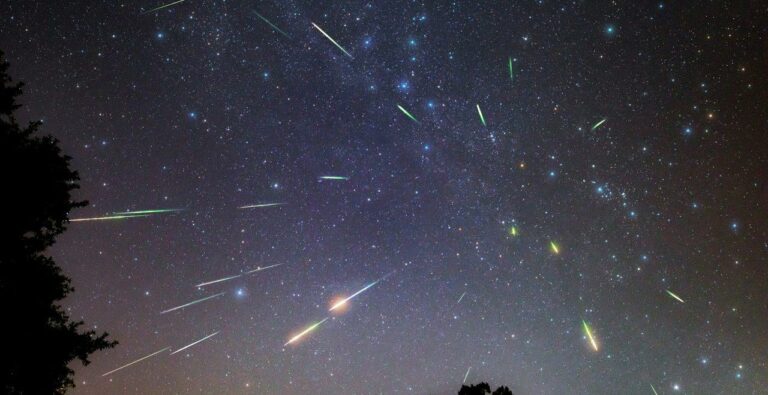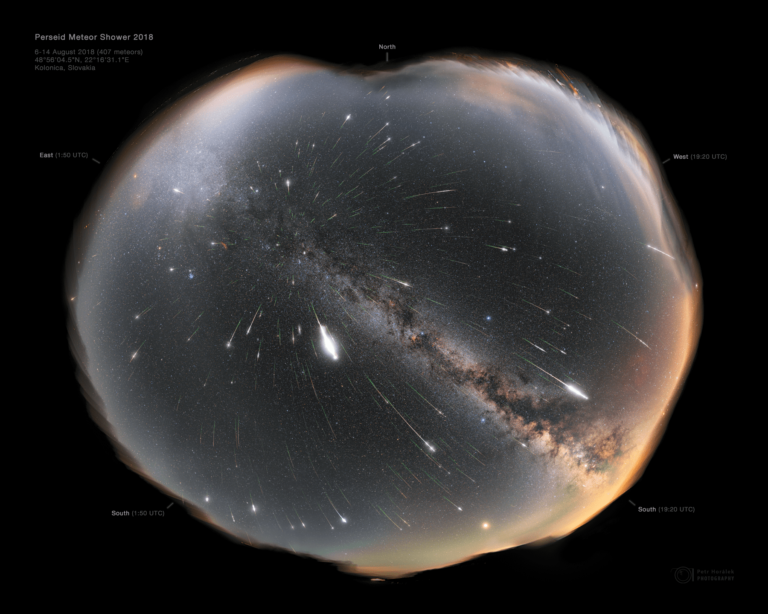Closer to the middle of August, headlines like: “Don’t miss the Perseids” or “The most powerful starfall awaits us” (most often — with exclamation marks at the end) begin to appear in the media. What are the Perseids and can they be considered something unique? How and where is it better to observe them?

The meteor phenomenon occurs when a solid particle of interplanetary dust flies into the Earth’s atmosphere at high speed. Colliding with atmospheric gas molecules, it heats up and evaporates, leaving behind a hot glowing plume — a meteor trail. Most of these particles do not exceed a grain of sand in size. If the “cosmic messenger” turns out to be large enough that some part of it does not evaporate and fall to Earth, it is called a meteorite.
The main “supplier” of cosmic dust in the vicinity of the Earth’s orbit are comets. The particles ejected by them move along approximately the same trajectory as their “progenitor”, therefore, for ground observers, their traces look divergent from one point — the radiant. With a few exceptions, meteor showers are named after the constellation where their radiant is located. Accordingly, the Perseids seem to us to be “flying out” from the constellation Perseus.
It is obvious that meteors have a chance to fly into the Earth’s atmosphere only if their orbit intersects with the Earth’s. The Perseid shower particles were ejected at various times by the Swift-Tuttle comet (109P/Swift-Tuttle). The Earth passes closest to its trajectory on August 12-13, when the maximum flow is observed, however, since the size of the meteor swarm is large enough, it is active almost the entire last summer month.
What is so remarkable about the Perseids for terrestrial observers? Among the annual meteor showers, they occupy the third place in power, second only to the Geminids (radiant in the constellation Gemini) and the η-Aquariids (radiant in the constellation Aquarius). The latter are associated with the famous Halley comet (1P/Halley), but it is very inconvenient to observe them in our latitudes — their maximum falls at the beginning of May, when the radiant of this shower rises shortly before dawn and does not have time to rise high above the horizon. Residents of the Southern Hemisphere in this case have a noticeable advantage.
Geminids, “producing” up to a maximum of hundreds of meteors per hour (about twice as many as the Perseids), are perfectly visible in Europe, but their activity peaks in mid-December, when the weather is mostly cloudy, and in general people prefer to stay at home at night in winter, while August favors night walks in the fresh air, in which it is difficult not to pay attention to the starry sky. That is why the “August starfall” is so popular. It is also worth noting that at least three more fairly powerful showers are active this month: in the first half of August, the Perseids are “helped” by the Northern and Southern δ-Aquariids, in the second — Cygnids (with a radiant in the constellation Cygnus).

But even the total activity of these showers, sometimes reaching hundreds of meteors visible to the naked eye per hour, is far from a “star shower” in its astronomical sense; for this, the hourly number of “falling stars” must be at least a thousand. Approximately as many Perseids were observed on August 13, 1993 (by that time it was daylight in Eastern Europe), 8 months after the Swift-Tuttle comet last approached the Sun. Its next return will take place in the distant year 2126.
This year, the maximum of the Perseid shower is expected on August 12, its activity will not exceed the usual values (50-60 meteors per hour). The young Moon will quickly disappear behind the horizon in the evening and will not interfere with observations, therefore, having gone further out of town and out into the open, we will be able to fully enjoy the “heavenly show” — not so rare but no less beautiful.
Follow us on Twitter to get the most interesting space news in time
https://twitter.com/ust_magazine
